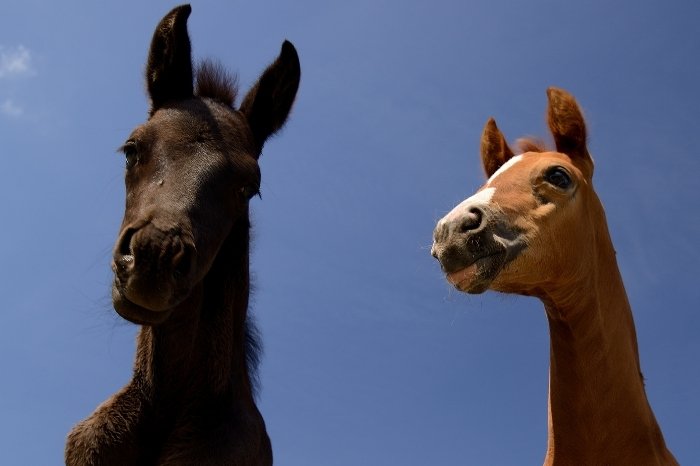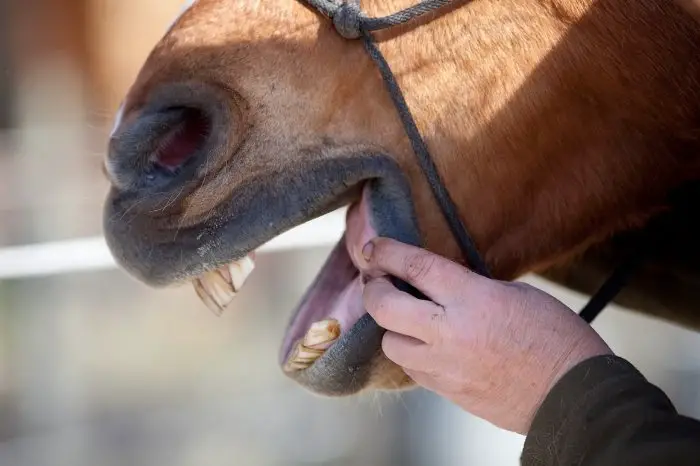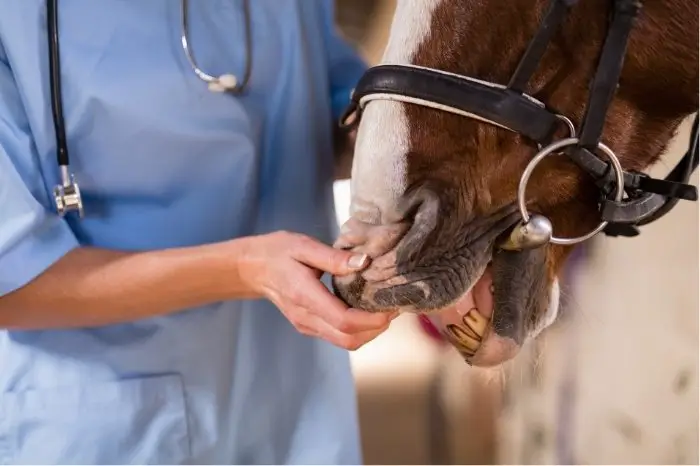Last Updated on March 12, 2022
Looking at a horse’s teeth can be an effective way to find their age. Using a horse teeth age chart can help you understand the major ways age is factored by teeth. Though it is not an exact science, it can generally allow you to figure out a horse’s age give or take a couple of years.
Equine dentists and veterinarians have been using teeth to determine age in a horse for a long time. Since horses’ teeth change as they age, it allows experts to use the appearance of the teeth to estimate age. However, there are outside factors that can affect the accuracy of this method.
Foal Teeth – Horse Teeth Age Chart
Upon birth, a foal will develop baby teeth, which are also known as deciduous teeth. A foal will have a total of 24 deciduous teeth, 12 incisors, and 12 premolars.
Deciduous teeth erupt upon birth and continue until around nine months of age. Foals will erupt their incisor teeth in the front first, followed by the premolars.

At around one year, they begin erupting their permanent adult teeth, losing their deciduous teeth. Though the process of a foal gaining, losing, and developing adult teeth follows a general timeline, it can vary by individual horse.
Foal Teeth Chart
| Age | Deciduous Teeth (Incisors) |
|---|---|
| 1 Week | Central (01) |
| 4-6 Weeks | Middle (02) |
| 6-9 Months | Corner (03) |
Adult Horse Teeth And Horse Teeth Age Chart
Permanent adult horse teeth will begin to erupt at around one year and continue until a horse is about five years old. An adult horse will have 36-44 teeth, with every adult horse having 12 incisors, 12 premolars, and 12 molars. Horses may also have 0-4 wolf teeth and 0-4 canine teeth, though these are normally only present in male horses.
Since a horse’s permanent teeth will erupt through the age of five, this is the easiest age range to determine the age. However, as horse ages, different factors such as cups, angle of incidence, surface shape, and Galvayne’s groove are used to help determine a horse’s age.
The molars are typically the first to erupt on a horse, coming in between ages one to two years. Next come the incisors, premolars, and the remaining molars between the ages of two and five years.
If wolf teeth come in, they will generally develop at around six months old. Canine teeth will generally come in between four to five years if a horse gets them.
Horse Teeth Chart
| Type of Tooth | Number | Permanent |
| Incisor | First (central) | 2.5 years |
| Incisor | Second (intermediate) | 3.5- 4 years |
| Incisor | Third (corner) | 4.5- 5 years |
| Canine | 3.5-6 years (typically 4-5) if ever | |
| Premolar | First (wolf) | Around 6 months, if ever |
| Premolar | Second | 2- 3 years |
| Premolar | Third | 2.5- 3 years |
| Premolar | Fourth | 3- 4 years |
| Molar | First | Around one year |
| Molar | Second | 2 years |
| Molar | Third | 3-4 years |
Aging A Horse By Its Teeth
After five years old, once horses have all of their teeth in, it can be a bit tricker to get their exact age. However, there are four main ways you can detect a horse’s age by their teeth: occurrence of permanent teeth, the disappearance of cups, angle of incidence, and surface shape. In addition, Galvayne’s Groove can also be used to determine the age of an older horse.
Horse teeth’ anatomy changes as they age, which allows people to get a good estimate of a horse’s age. These changes occur naturally, however, sometimes outside influences will affect a horse’s teeth.
Check Out What Makes A Horse Sweat Foam?
Occurrence Of Permanent Teeth – Horse Teeth Age Chart
From the ages of one to around five years old, a horse will erupt all of its permanent teeth. Each year in this time frame, you will be able to get a very accurate estimate of a horse’s age.
Equine Dental Kit Set 4000 Series Speculums with 3 Floats with Blades Premmium, Set
Permanent teeth in horses are darker and longer, while also not having the well-defined neck joining root and gum that baby teeth have. Tracking the occurrence of permanent teeth will allow to you accurately determine a horse’s age from one to five years.
Read more about What Is A Sun Bleached Horse, And How Do You Prevent It?
Disappearance Of Cups
When horses first get their permanent teeth they have deep indentures in the center of their surfaces, known as cups. Cups are often used as reference points in determining the age of a horse.
Upper teeth tend to have deeper cups than the lower teeth do. Due to this, they do not wear evenly with the surface or become “smooth” over equal periods of time. Oftentimes, the cups in the lower centers, intermediates, corners, upper centers, intermediates, and corners become smooth between the ages of 6-11 years.
Most horses will have a “smooth mouth” by the age of 11. As cups disappear in teeth, dental stars appear. Dental stars appear as narrow, yellow lines in front of the central enamel ring. As a horse age, they then develop dark circles near the center of the tooth with advanced age.
At around ten years old, the dental star will appear as a smooth line and at around 15 years old, it will appear as an oval near the center. When a horse is around 20 years old, the dental star will be round in the center.
Angle Of Incidence – Horse Teeth Age Chart
The angle of incidence forms by where the upper and lower incisor teeth meet. The angle starts at approximately 160 to 180 degrees and changes as a horse ages.
At around five years, the angle will be approximately 180 degrees. The older the horse is, the more acute this angle will be. By around age 20, the angle will be approximately 90 degrees.
Surface Shape Of the Teeth
In young horses, teeth will appear broad and flat, but as they age this will change. The teeth will often be as much as twice as wide, from side to side, as they are deep, front to rear.
When a horse is around 8 to 12 years the back inside surfaces will become oval and then around the age of 15, they will become triangular. At twenty years old, a horse’s teeth may change to be twice as deep from the front to the rear as they are wide.
Galvayne’s Groove – Horse Teeth Age Chart
Invented in the 18th century by horse trainer Sydney Galvayne, the Galvayne’s groove is another way to determine age in older horses. Galvayne’s groove is a vertical, dark-filled groove that is located on the lateral surface of the upper third incisor.
The line first appears at the gum at around age 10. By age 15, the groove is halfway down the tooth, and by age 20 it is all the way down the tooth. By age 25, the groove is halfway gone and by age 30 it has disappeared.
Outside Factors
There are also outside factors that can affect a horse’s teeth, making it more difficult to determine the age. Factors that can change a horse’s teeth include cribbing, genetics, nutrition, and environment.
Aging A Horse By Its Teeth
In many cases, you can get a good idea of a horse’s age by looking at its teeth. Occurrence of permanent teeth, the disappearance of cups, angle of incidence, surface shape, and Galvayne’s groove are the best factors to determine age.
Do you have any questions regarding how to use a horse teeth age chart? If so, please ask any questions regarding horse teeth in the comments.



